Geogrids provide stabilisation or reinforcement to enhance the performance of soils, as well as separation between soil and aggregate layers. There are four main types of geogrid, each with different physical properties or characteristics. The most suitable type of geogrid in any given application will depend on both these physical properties along with the compatibility of the aggregate and soil.
In this guide, we’ll be looking at the physical properties of geogrids and how they impact suitability, before looking more closely at the key properties of Tensar geogrids in particular.
Use the links below to jump to the section you’re most interested in:
Geogrid Strength
In the context of geogrids, strength can mean a number of different things, including:
- Geogrid tensile strength
- Geogrid design strength
- Geogrid creep strength
However, when assessing potential performance, other physical properties of geogrids should be considered, such as:
- radial stiffness
- junction efficiency
- resistance to degradation and weathering
Ultimate tensile strength of geogrids
Ultimate tensile strength is the maximum amount of load a geogrid can handle before performance is compromised.
This is established through tensile testing, where the geogrid is stretched until it breaks.
Why ultimate tensile strength is not important for geogrid performance
Many geogrid specifications focus on tensile strength, equating high ultimate tensile strength (UTS) with better performance. In reality, however, UTS is irrelevant, particularly when a geogrid is used in the design of roads or temporary working platforms.
In these cases, the ultimate tensile strength of a geogrid alone is actually a poor indicator of performance.
This is because the ‘tensioned membrane’ effect—the strength that a geogrid offers when stretched or strained—does not offer appropriate support for the layers above it.
To work, the geogrid has to be stretched. But when a load is placed on it, the geogrid will curve to accommodate this load, similar to what happens when a person sits on a hammock.
Consequently, the pavement will suffer deformation at the level where the reinforcement geogrid is placed. Deformation will also likely appear at the road surface level, in the form of rutting, cracks and potholes, reducing its operational life.

Geogrid junction efficiency
The physical property of geogrids known as junction efficiency is the measure of the strength of the node compared to the strength of the rib, expressed as a percentage and indicates the ability of the geogrid to transfer loads from one rib to other ribs in different directions:

Junction efficiency vs. tensile strength
Where geogrids are used to take advantage of the ‘confinement effect’, junction efficiency is the more important physical property in relation to performance in road and temporary working platforms than tensile strength.
The confinement effect—where the aggregate catches in the apertures of the geogrid and pushes up against its ribs, preventing the material from moving laterally (sideways).
Pressure is put against the ribs, which are held in place by the nodes. As a result, the efficiency of the node compared to the rib is a much better indicator of:
- how well the geogrid will stabilise the ground
- how effectively the road or temporary working platform will perform
Junction efficiency is formally recognised by the European Assessment Document
Junction efficiency—and not junction strength—is a parameter the European Assessment Document (EAD) characterises and associates with stabilisation geogrid performance.
The EAD sets out parameters the European Organisation for Technical Assessment (EOTA) confirms are specific to the distinct function of stabilisation. No such link has been made between any junction parameters and reinforcement geogrids
Radial stiffness
The physical property of geogrids known as radial stiffness is the ability to evenly distribute a load through 360 degrees, without deforming elastically.
Radial stiffness is a characteristic of Tensar’s TriAx geogrid associated with the stabilisation function, with the geogrid acting as a component of a mechanically stabilised layer in road applications. TriAx’s hexagonal shape provides a more uniform response to the load traffic imposed on the road than geogrids with square or rectangular apertures.
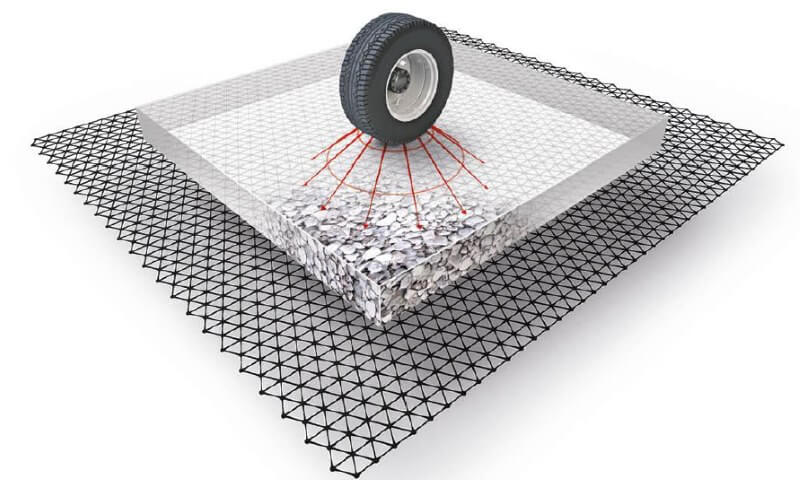
Geogrid size and aperture size

There are different-sized geogrids for a range of fill particle sizes to ensure the aggregate is properly confined. For TriAx geogrids, finer fills need smaller apertures, while aggregate in larger particles will require bigger apertures. TriAx geogrids come in three sizes:
- 66mm
- 80mm
- 120mmgThre
Elastic modulus
Elastic modulus is another physical property of geogrids related to stiffness, but not related to performance in ‘normal’ applications.
Finite element analysis (FEA) sometimes requires a geogrid’s elastic modulus. However, Tensar’s own research has confirmed that the effect of a geogrid should not be modelled on individual product parameters. We have developed an FEA module—for more information , contact the Tensar Technology team.
Long-term design strength
Long-term design strength (LTDS) is a relevant property of geogrids in reinforced soil applications—including retaining walls and slope reinforcement—where layers of geosynthetic materials (such as geogrids) are placed within the fill used to form the finished structure.
Unlike roads, which bear a constantly changing load, reinforced soil carries a permanent load throughout its operational life, which could be up to 120 years. Consequently, the design of the structure and load-bearing components (including the geogrids) should reflect this.
Factors used to calculate LTDS
Creep strength
Polymers are viscoelastic, which means that their strength and stiffness are affected by temperature and how frequently or how long they bear a load. Under a constant load, polymer geogrids will stretch very gradually as their physical properties change.
Creep strength can be assessed by subjecting geogrids to long-term loading. This involves suspending different-sized weights from the geogrid in temperature-controlled conditions and measuring and recording the strain for a standard duration of 10,000 hours, which is just over a year.
Partial reduction factors
Partial reduction factors—such as environmental effects and the effect of damage caused during installation—should be applied before using creep strength in LTDS calculations.
Uniaxial geogrids are also available in different grades but their geometry is similar across the range.

Physical properties of Tensar geogrids
Tensar supplies a number of geogrid solutions to solve geotechnical engineering problems across several applications. The physical properties for each of these have been outlined below:
Physical properties associated with Tensar InterAx® geogrids in roads and platforms
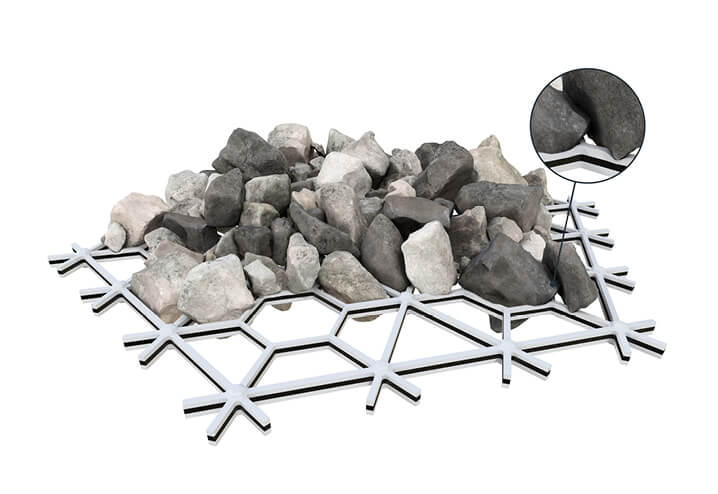
- Manufacturing process - coextrusion
- Three different aperture size - Triangular, hexagonal & trapezoidal
Tensar’s InterAx® geogrids are classified as stabilisation geogrids. The geogrid properties noted are associated with this distinct function.
Physical properties associated with TriAx geogrids in roads and platforms:
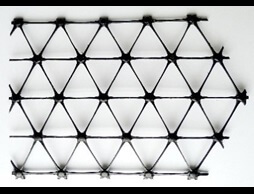
- Radial stiffness at 0.5%
- Radial stiffness ratio
- Junction efficiency
- Hexagonal pitch
Tensar’s TriAx geogrids are classified as stabilisation geogrids. The properties noted are associated with this distinct function.
Physical properties associated with biaxial geogrids in roads and platforms
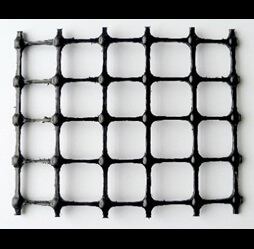
- Ultimate geogrid tensile strength
- Strength at 2% strain
- Strength at 5% strain
- Peak strain
Biaxial geogrids such as Tensar’s SS geogrid are classified as reinforcement products. Geogrid tensile strength and associated strain are properties relevant to this distinct function.
Physical properties of Tensar uniaxial geogrids in walls and slopes:
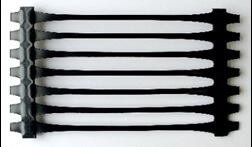
- Creep Strength
- Long-term design strength*
- Ultimate tensile strength**
Uniaxial geogrids such as Tensar’s RE geogrid are classified as reinforcement products, specifically for wall and slope applications.
Long-term design strength is based on project-specific conditions. Partial reduction factors should be applied based on variables such as in-soil temperature and installation damage.
**Ultimate tensile strength is not a parameter employed in design calculations but can be used to identify which product is required.
Properties of geogrids: key takeaways
This guide has explained the various physical properties of geogrids and their importance for certain types of application. The key points are summarised below:
- Physical properties associated with geogrids depend on the intended application.
- Always consider a geogrid’s performance in context as part of an overall system—the benefit is in how the geogrid interacts with the layers around it, not by virtue of its standalone properties.
- Most physical properties of geogrids used in the industry to gauge performance are inappropriate.
- Ultimate geogrid tensile strength is not the most important factor in how well it will perform, particularly in road applications – junction efficiency is a far more significant physical property in such cases, and its importance is formally recognised by the European Assessment Document.
Next steps
For further information about Tensar geogrids and their physical properties, visit our geogrids page. If you’ve enjoyed reading this guide and would like to see some other related resources, take a look at:


